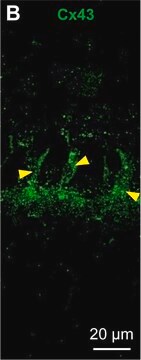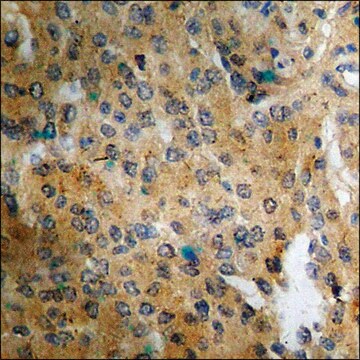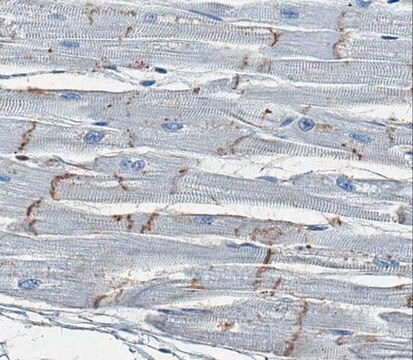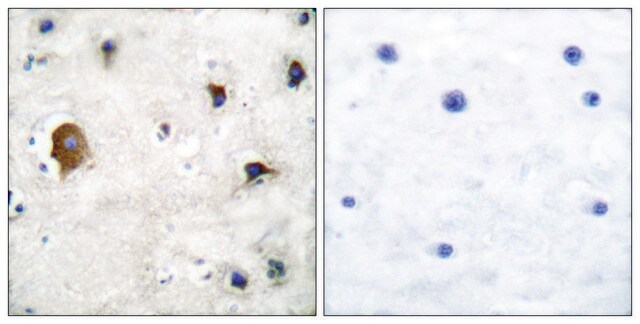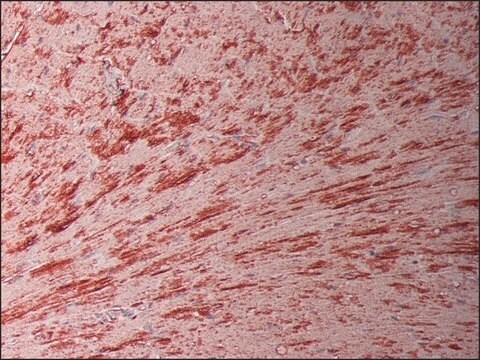MABT903
Anti-Connexin 43 Antibody, N-terminal Antibody, clone P1E11.B19
clone P1E11, from mouse
Sinônimo(s):
Gap junction alpha-1 protein, CX43, Gap junction 43 kDa heart protein
About This Item
Produtos recomendados
fonte biológica
mouse
Nível de qualidade
forma do anticorpo
purified immunoglobulin
tipo de produto de anticorpo
primary antibodies
clone
P1E11, monoclonal
reatividade de espécies
mouse, rat, human
reatividade da espécie (prevista por homologia)
bovine (based on 100% sequence homology), rabbit (based on 100% sequence homology), horse (based on 100% sequence homology), canine (based on 100% sequence homology), rhesus monkey (based on 100% sequence homology), chicken (based on 100% sequence homology), hamster (based on 100% sequence homology), porcine (based on 100% sequence homology)
técnica(s)
immunocytochemistry: suitable
western blot: suitable
Isotipo
IgG1κ
nº de adesão NCBI
nº de adesão UniProt
Condições de expedição
ambient
modificação pós-traducional do alvo
unmodified
Informações sobre genes
bovine ... Gja1(281193)
chicken ... Gja1(395278)
dog ... Gja1(403418)
horse ... Gja1(100067229)
human ... GJA1(2697)
mouse ... Gja1(14609)
rabbit ... Gja1(100008935)
rat ... Gja1(24392)
rhesus monkey ... Gja1(714344)
Descrição geral
Especificidade
Imunogênio
Aplicação
Cell Structure
Western Blotting Analysis (WB): A representative lot detected Connexin 43 in NRK cells (Courtesy of Joell Solan in Paul Lampe s Lab at Fred Hutchinson Cancer Research Center, Seattle, WA).
Western Blotting Analysis: A representative lot detected Connexin 43 in Western Blotting applications (Kalcheva, N., et. al. (2007). Proc Natl Acad Sci USA. 104(51):20512-6).
Western Blotting Analysis: 1-4 µg/mL from a representative lot detected Connexin 43 in 10 µg of rat and mouse heart tissue lysates.
Immunocytochemistry Analysis: A representative lot detected Connexin 43 in Immunocytochemistry applications (Gellhaus, A., et. al. (2004). J Biol Chem. 279(35):36931-42).
Western Blotting Analysis: A representative lot detected Connexin 43 in Western Blotting applications (Goldberg, G.S., et. al. (2002). J Biol Chem. 277(39):36725-30).
Western Blotting Analysis: A representative lot detected Connexin 43 in Western Blotting applications (Solan, J.L., et. al. (2003). J Cell Sci. 116(Pt 11):2203-11).
Qualidade
Western Blotting Analysis: 1 µg/mL of this antibody detected Connexin 43 in 10 µg of human heart tissue lysates.
Descrição-alvo
forma física
Armazenamento e estabilidade
Outras notas
Exoneração de responsabilidade
Não está encontrando o produto certo?
Experimente o nosso Ferramenta de seleção de produtos.
Código de classe de armazenamento
12 - Non Combustible Liquids
Classe de risco de água (WGK)
WGK 1
Certificados de análise (COA)
Busque Certificados de análise (COA) digitando o Número do Lote do produto. Os números de lote e remessa podem ser encontrados no rótulo de um produto após a palavra “Lot” ou “Batch”.
Já possui este produto?
Encontre a documentação dos produtos que você adquiriu recentemente na biblioteca de documentos.
Nossa equipe de cientistas tem experiência em todas as áreas de pesquisa, incluindo Life Sciences, ciência de materiais, síntese química, cromatografia, química analítica e muitas outras.
Entre em contato com a assistência técnica